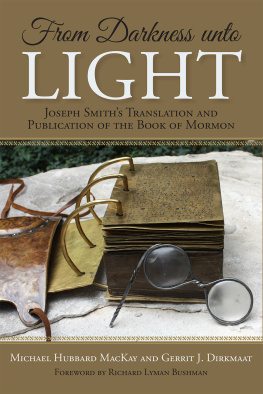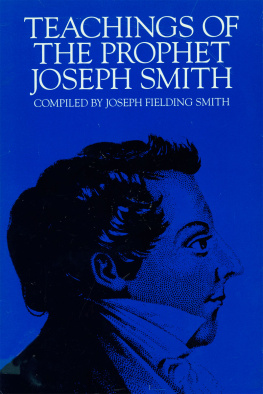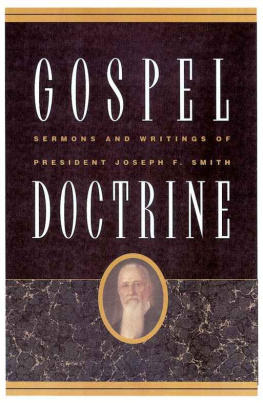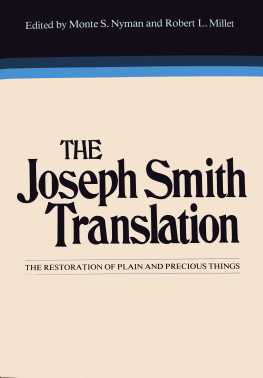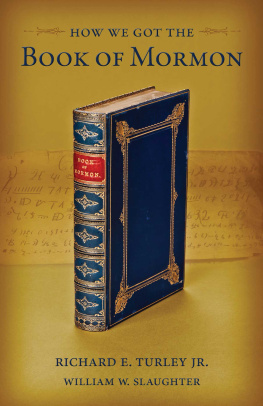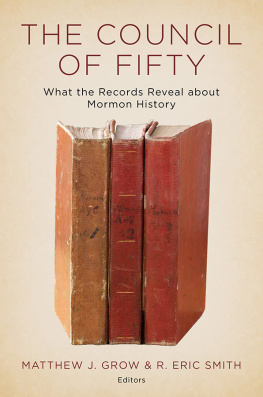From Darkness Unto Light
Michael Hubbard McKay, Gerrit J. Dirkmaat
2015 Brigham Young University.
Any uses of this material beyond those allowed by the exemptions in U.S. copyright law, such as section 107, Fair Use, and section 108, Library Copying, require the written permission of the publisher, Religious Studies Center, 167 HGB, Brigham Young University, Provo, Utah 84602. The views expressed herein are the responsibility of the authors and do not necessarily represent the position of Brigham Young University or the Religious Studies Center.
Published by the Religious Studies Center, Brigham Young University, Provo, Utah, in cooperation with Deseret Book Company, Salt Lake City.Visit us at rsc.byu.edu.
2015 by Brigham Young University. All rights reserved.
Printed in the United States of America by Sheridan Books, Inc.
Deseret Book is a registered trademark of Deseret Book Company.Visit us at DeseretBook.com.
Any uses of this material beyond those allowed by the exemptions in US copyright law, such as section 107, Fair Use, and section 108, Library Copying, require the written permission of the publisher, Religious Studies Center, 185 HGB, Brigham Young University, Provo, Utah 84602. The views expressed herein are the responsibility of the authors and do not necessarily represent the position of Brigham Young University or the Religious Studies Center.
ISBN: 978-0-8425-2888-7Retail US: $24.99
Cover design by Madison SwappInterior design by Madison Swapp
Front cover photo by Gerrit J. Dirkmaat
Library of Congress Cataloging-in-Publication Data
MacKay, Michael Hubbard.
From darkness unto light : Joseph Smiths translation and publication of the Book of Mormon / Michael Hubbard MacKay and Gerrit J. Dirkmaat ; foreword by Richard Lyman Bushman.
pages cm
Includes bibliographical references and index.
ISBN 978-0-8425-2888-7
1. Book of Mormon--History. I. Title.
BX8627.M245 2015
289.322--dc23
2014046675

Replicas of the gold plates, spectacles, and breastplate. Photo by Gerrit J. Dirkmaat.
Foreword

This volume is the first of what could be many potential histories coming out of the Joseph Smith Papers Project. Michael Hubbard MacKay and Gerrit Dirkmaat have been editors of the Documents series, which is just beginning to appear. The results of this research can be partially found in the introductions, headnotes, and footnotes of The Joseph Smith Papers volumes, but the findings will be properly valued only when integrated into the narrative of early Church history. Only then will readers grasp what the new discoveries mean. The two authors have done just that for Joseph Smiths early years from the recovery of the plates in September 1827 through the publication of the Book of Mormon in March 1830.
Books like this one will bring Latter-day Saint readers up to date on the results of the latest historical research. While, like all histories, From Darkness unto Light is necessarily an interpretation, the authors base their story firmly on the original sources. They get down to what historians consider to be the bedrock of historical construction. Working from original materials, the authors introduce readers to aspects of early Church history that are well known to historians but that are not necessarily common knowledge in the Church. MacKay and Dirkmaat also reveal brand new findings in this work. They speak at length, for example, about Joseph Smiths use of two seer stones in translation. In translating, Joseph probably first used the stones set in spectacles that came with the plates, and then, for most of the translation period, substituted one of the stones he had found. Joseph put the seer stone in a hat to exclude the light and read off the translated text by looking in the stone. All the while, the plates lay wrapped in a cloth on the table. Apparently Joseph did not look at the plates through most of the translation.
This description will startle Latter-day Saints who are familiar with artistic depictions showing Joseph Smith translating with a finger on the plates while he writes down the words as they come to him. The image of Joseph with his face in the hat as he translates is not so well known and is much less decorous, which may shock some readers. But it is essential that the Church at large become aware of what historians have discovered in the sources. Failure to acknowledge these factual accounts, almost all of them in friendly sources, can devastate Latter-day Saints who run across them. Feeling that the Church has covered up the truth, they become disillusioned and even angry. This book is an attempt to repair the misconceptions so that the next generation of Latter-day Saints will be better informed.
For years Mormon scholars simply disregarded critical sources, such as the affidavits concerning the Smith family in E. D. Howes Mormonism Unvailed. They felt the critical writings were too biased to be of any use. But in recent years, automatic exclusion of negative reports is no longer the practice. Everything has to be examined and evaluated. MacKay and Dirkmaat work on the principle that bias must be taken into account in analyzing any historical source. The art of the historian is to extract useful information from original sources whether negative or positive. The notes of From Darkness unto Light show the authors ranging through sources all across the spectrum. The result is a much enriched and compelling narrative, one that will hold up under critical scrutiny.
In the books pages, one can almost hear MacKay and Dirkmaat debating the implications of the evidence they turn up. What does this mean? Are we assuming too much? What about the contradictory evidence? Good documentary editors pursue details that most historians overlook or cannot spare the time to investigate: how much profit E. B. Grandin was going to make on publication of the Book of Mormon, for example. Was he dependent on sales of the book to recover his costs? Did he lose money? The authors find that the price he charged$3,000 for 5,000 copiespromised him far more than the 12 percent printers customarily hoped for. Grandins projected profit was 33 percent above his costs. Furthermore, once the expenditure was secured by a mortgage on Martin Harriss farm, Grandin was home free. He sold the mortgage to a wealthy Palmyran, Thomas Rogers, for $2,000enough to assure him his 12 percent profitand Rogers in turn resold it soon after for $3,000. Everyone benefited financially, save for Harris, who lost his farm. The book pokes into corners like that where no one has looked before.
Some of the investigations have had lasting effect. The search for Martin Harriss mortgage to E. B. Grandin in August 1829, for example, has affected the dating of section 19 of the Doctrine and Covenants. The revelation, which warns Harris of the dangers of refusing to finance publication of the Book of Mormon, has for a long time been dated March 1830, but the insistence on Harriss support in 1830 made no sense coming seven months after he had already mortgaged his farm in 1829. Careful examination of the various versions of section 19 revealed that the date was placed in parentheses in the original printing, indicating the compilers uncertainty about its accuracy. Over time the parentheses were omitted, and March 1830 was accepted as fact. Now that mistake has been corrected. The most recent edition of the Doctrine and Covenants changes the date of section 19 to summer 1829 in keeping with the new knowledge about Harriss mortgage.

